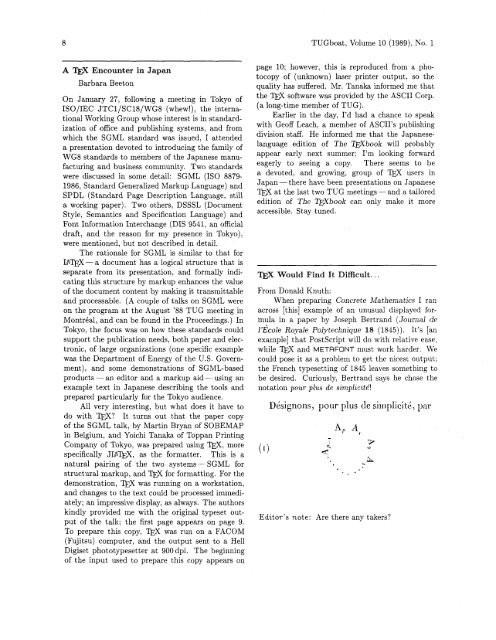Complete issue 10:1 as one pdf - TUG
Complete issue 10:1 as one pdf - TUG
Complete issue 10:1 as one pdf - TUG
Create successful ePaper yourself
Turn your PDF publications into a flip-book with our unique Google optimized e-Paper software.
<strong>TUG</strong>boat, Volume <strong>10</strong> (1989), No. 1<br />
A TEX Encounter in Japan<br />
Barbara Beeton<br />
On January 27, following a meeting in Tokyo of<br />
ISO/IEC JTCl/SCl8/WG8 (whew!), the international<br />
Working Group whose interest is in standardization<br />
of office and publishing systems, and from<br />
which the SGML standard w<strong>as</strong> <strong>issue</strong>d, I attended<br />
a presentation devoted to introducing the family of<br />
WG8 standards to members of the Japanese manufacturing<br />
and business community. Two standards<br />
were discussed in some detail: SGML (IS0 8879-<br />
1986, Standard Generalized Markup Language) and<br />
SPDL (Standard Page Description Language, still<br />
a working paper). Two others, DSSSL (Document<br />
Style, Semantics and Specification Language) and<br />
Font Information Interchange (DIS 9541, an official<br />
draft, and the re<strong>as</strong>on for my presence in Tokyo),<br />
were menti<strong>one</strong>d, but not described in detail.<br />
The rationale for SGML is similar to that for<br />
IP'-a document h<strong>as</strong> a logical structure that is<br />
separate from its presentation, and formally indicating<br />
this structure by markup enhances the value<br />
of the document content by making it transmittable<br />
and processable. (A couple of talks on SGML were<br />
on the program at the August '88 <strong>TUG</strong> meeting in<br />
Montrkal, and can be found in the Proceedings.) In<br />
Tokyo, the focus w<strong>as</strong> on how these standards could<br />
support the publication needs, both paper and electronic,<br />
of large organizations (<strong>one</strong> specific example<br />
w<strong>as</strong> the Department of Energy of the U.S. Government),<br />
and some demonstrations of SGML-b<strong>as</strong>ed<br />
products - an editor and a markup aid - using an<br />
example text in Japanese describing the tools and<br />
prepared particularly for the Tokyo audience.<br />
All very interesting, but what does it have to<br />
do with 'l&X? It turns out that the paper copy<br />
of the SGML talk, by Martin Bryan of SOBEMAP<br />
in Belgium, and Yoichi Tanaka of Toppan Printing<br />
Company of Tokyo, w<strong>as</strong> prepared using m, more<br />
specifically JIPW, <strong>as</strong> the formatter. This is a<br />
natural pairing of the two systems-SGML for<br />
structural markup, and T@ for formatting. For the<br />
demonstration, l)$ w<strong>as</strong> running on a workstation,<br />
and changes to the text could be processed immediately;<br />
an impressive display, <strong>as</strong> always. The authors<br />
kindly provided me with the original typeset output<br />
of the talk; the first page appears on page 9.<br />
To prepare this copy, w<strong>as</strong> run on a FACOM<br />
(Fujitsu) computer, and the output sent to a Hell<br />
Digiset phototypesetter at 900 dpi. The beginning<br />
of the input used to prepare this copy appears on<br />
page <strong>10</strong>; however, this is reproduced from a photocopy<br />
of (unknown) l<strong>as</strong>er printer output, so the<br />
quality h<strong>as</strong> suffered. Mr. Tanaka informed me that<br />
the l)$ software w<strong>as</strong> provided by the ASCII Corp.<br />
(a long-time member of <strong>TUG</strong>).<br />
Earlier in the day, I'd had a chance to speak<br />
with Geoff Leach, a member of ASCII's publishing<br />
division staff. He informed me that the Japaneselanguage<br />
edition of The mbook will probably<br />
appear early next summer; I'm looking forward<br />
eagerly to seeing a copy. There seems to be<br />
a devoted, and growing, group of TEX users in<br />
Japan- there have been presentations on Japanese<br />
at the l<strong>as</strong>t two <strong>TUG</strong> meetings - and a tailored<br />
edition of The pbook can only make it more<br />
accessible. Stay tuned.<br />
l&X Would Find It Difficult.. .<br />
From Donald Knuth:<br />
When preparing Concrete Mathematics I ran<br />
across [this] example of an unusual displayed formula<br />
in a paper by Joseph Bertrand (Journal de<br />
1'~cole Royale Polytechnique 18 (1845)). It's [an<br />
example] that Postscript will do with relative e<strong>as</strong>e,<br />
while EX and METAFONT must work harder. We<br />
could pose it <strong>as</strong> a problem to get the nicest output;<br />
the French typesetting of 1845 leaves something to<br />
be desired. Curiously, Bertrand says he chose the<br />
notation pour plus de simplicite'!<br />
Dksignons, pour plus tle si~r~j)licitci, par<br />
Editor's note: Are there any takers?

















